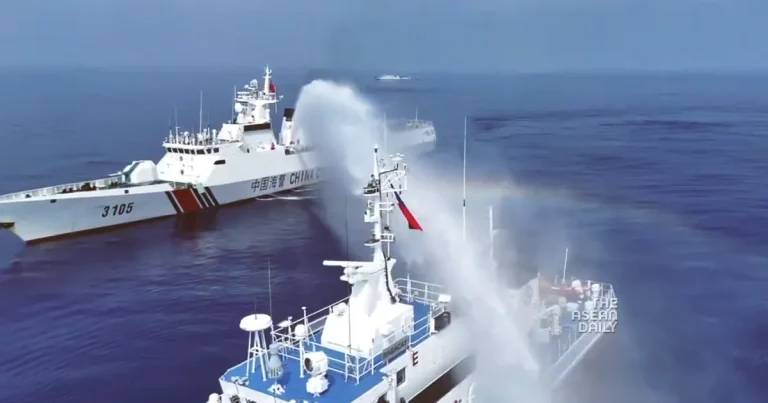2-5-2024 (MANILA) Tensions in the strategically vital South China Sea have escalated after the Philippine government summoned a senior Chinese diplomat to protest the “harassment, ramming, swarming, shadowing and blocking” of its vessels by Beijing’s maritime forces. The strongly-worded rebuke, confirmed by the Department of Foreign Affairs on Tuesday, came in response to an incident on April 30th in which China Coast Guard and maritime militia ships allegedly engaged in “dangerous manoeuvres” and deployed water cannons against Philippine patrol boats.
In a formal protest delivered to Zhou Zhiyong, the second-highest ranking official at Beijing’s embassy in the Philippine capital, Manila condemned the purported “aggressive actions” which inflicted damage upon vessels operated by both the Philippine Coast Guard (PCG) and Bureau of Fisheries and Aquatic Resources (BFAR). The diplomatically-charged demarche demanded Chinese maritime forces “leave Bajo de Masinloc and its vicinity immediately” – referring to the Filipino name for the Chinese-controlled Scarborough Shoal flashpoint.
“The Philippines protested the harassment, ramming, swarming, shadowing and blocking, dangerous manoeuvres, use of water cannons, and other aggressive actions of China Coast Guard and Chinese Maritime Militia vessels against Filipino government vessels,” the Department proclaimed in a statement. No immediate response was forthcoming from the Chinese embassy.
The latest flare-up in the continent’s paramount maritime territorial feud occurred as Philippine boats conducted a resupply mission to regional fishermen near the Scarborough Shoal – a resource-rich reef under Beijing’s control since 2012. Commenting on the incident days earlier, Chinese Foreign Ministry spokesman Lin Jian asserted the Coast Guard undertook “necessary measures” against Philippine ships which “infringed on Beijing’s territory” – insisting such actions were “professional” and “in accordance with the law.”
“Water cannon ka lang, Philippine flag ako.”
WATCH: The Philippine flag still flying proudly after being pounded by a Chinese Coast Guard water cannon. | via @raffytima pic.twitter.com/9VWPNJDZNn
— GMA Integrated News (@gmanews) May 1, 2024
The provocative standoff compounds already feverish Sino-Philippine tensions exacerbated by the contemporaneous hosting of the nations’ largest annual joint military exercises with the United States – war games which have drawn withering condemnation from Beijing. Indeed, the incident marks the latest in a rapidly escalating succession of maritime confrontations between the two powers’ maritime forces across the disputed South China Sea.
Representing over a third of annual global maritime trade flows, the resource-abundant South China Sea represents a strategic pearl over which the Philippines, China, Vietnam, Malaysia, Taiwan and Brunei have tussled for decades. However, no other nation’s territorial claims are as sweeping or zealously enforced as Beijing’s “nine-dash line” encompassing nearly the entire sea – a policy backed by the world’s largest maritime militia and rapidly-expanding artificial islands.
Consequently, the Philippines has emerged as one of China’s most steadfast maritime antagonists, persistently protesting and legally challenging Beijing’s expansive sovereignty claims – which comprehensively reject both international laws and a 2016 UN-backed tribunal ruling. Under outgoing President Rodrigo Duterte, Manila calibrated a cautious balancing act by protesting Chinese incursions without jeopardising crucial economic ties – an approach now under scrutiny as hardline figures jostle to succeed him.




